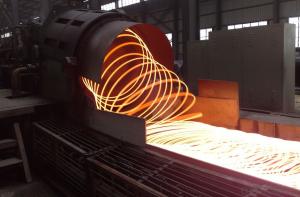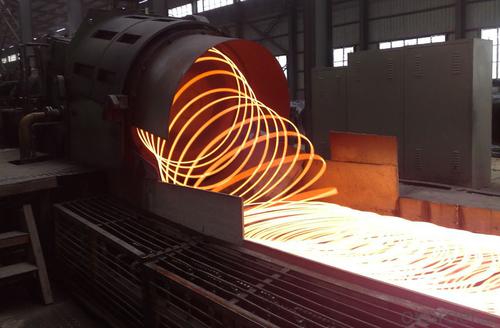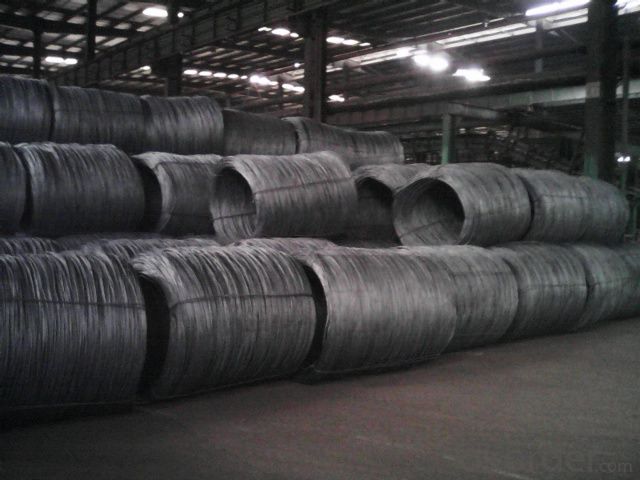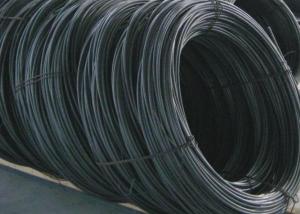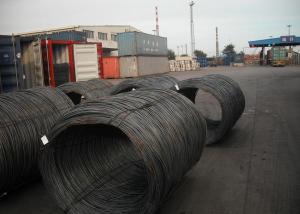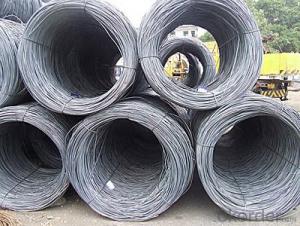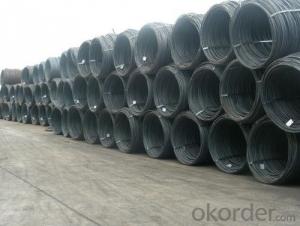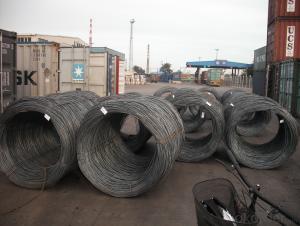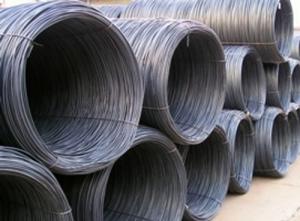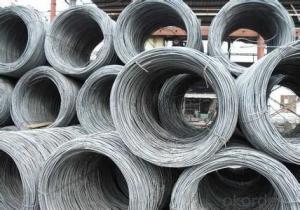Hot Rolled Low Carbon Steel Wire Rod
- Loading Port:
- China Main Port
- Payment Terms:
- TT or LC
- Min Order Qty:
- 100 m.t.
- Supply Capability:
- 10000 m.t./month
OKorder Service Pledge
OKorder Financial Service
You Might Also Like
Product Description:
OKorder is offering Hot Rolled Low Carbon Steel Wire Rod at great prices with worldwide shipping. Our supplier is a world-class manufacturer of steel, with our products utilized the world over. OKorder annually supplies products to African, South American and Asian markets. We provide quotations within 24 hours of receiving an inquiry and guarantee competitive prices.
Product Applications:
Hot Rolled Low Carbon Steel Wire Rod are ideal for structural applications and are widely used in the construction of buildings and bridges, and the manufacturing, petrochemical, and transportation industries.
Product Advantages:
OKorder's Hot Rolled Low Carbon Steel Wire Rod are durable, strong, and wide variety of sizes.
Main Product Features:
· Premium quality
· Prompt delivery & seaworthy packing (30 days after receiving deposit)
· Can be recycled and reused
· Mill test certification
· Professional Service
· Competitive pricing
Product Specifications:
Steel Grade: Q195/235, SAE1006-1018B
Standard: ASTM, GB
Diameter: 5.5mm, 6.5mm, 7mm,8mm,9mm,10mm,12mm,14mm
Type: in coil, coil weight around 2MT
Alloy or Not: Alloy
Technique: Hot Rolled
Place of Origin: China Mainland
Surface: round, no twisted, light and smooth
Grade | Chemical Composition(%) | |||||
C | Mn | Si | S | P | B | |
SAE1006B | 0.03~O.07 | ≤0.32 | ≤0.30 | ≤0.045 | ≤0.040 | >0.0008 |
Mechanical properties | ||||||
Yield strength(N/mm2) | Tensile strength(N/mm2) | Elongation(%) | ||||
250-280 | 350-380 | ≥32 | ||||
Grade | Chemical Composition(%) | |||||
C | Mn | Si | S | P | B | |
SAE1008B | 0.10max | 0.3~O.50 | 0.15max | 0.050max | 0.040 max | 0.0008 min |
Mechanical properties | ||||||
Yield strength(N/mm2) | Tensile strength(N/mm2) | Elongation(%) | ||||
≥195 | 315-430 | ≥30 | ||||
Grade | Chemical Composition(%) | |||||
C | Mn | Si | S | P | B | |
Q195B | 0.06~O.12 | 0.25~O.50 | ≤0.30 | ≤0.050 | ≤0.045 | >0.0008 |
Mechanical properties | ||||||
Yield strength(N/mm2) | Tensile strength(N/mm2) | Elongation(%) | ||||
≥195 | 315-430 | ≥33 | ||||
Grade | Chemical Composition(%) | |||||
C | Mn | Si | S | P | B | |
Q235B | 0.12~O.2 | 0.3~O.701 | ≤0.30 | ≤0.045 | ≤0.045 | >0.0008 |
Mechanical properties | ||||||
Yield strength(N/mm2) | Tensile strength(N/mm2) | Elongation(%) | ||||
235 | 375-500 | ≥26 | ||||
FAQ:
Q1: Why buy Materials & Equipment from OKorder.com?
A1: All products offered byOKorder.com are carefully selected from China's most reliable manufacturing enterprises. Through its ISO certifications, OKorder.com adheres to the highest standards and a commitment to supply chain safety and customer satisfaction.
Q2: How do we guarantee the quality of our products?
A2: We have established an advanced quality management system which conducts strict quality tests at every step, from raw materials to the final product. At the same time, we provide extensive follow-up service assurances as required.
Q3: How soon can we receive the product after purchase?
A3: Within three days of placing an order, we will arrange production. The normal sizes with the normal grade can be produced within one month. The specific shipping date is dependent upon international and government factors, the delivery to international main port about 45-60days.
Images:
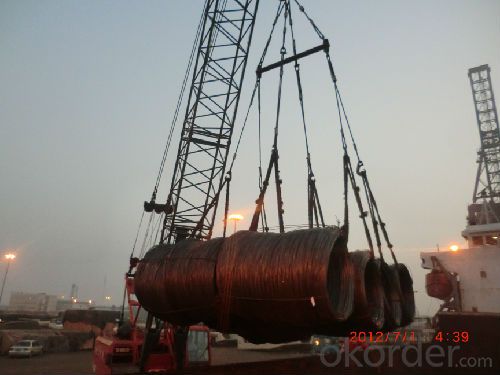
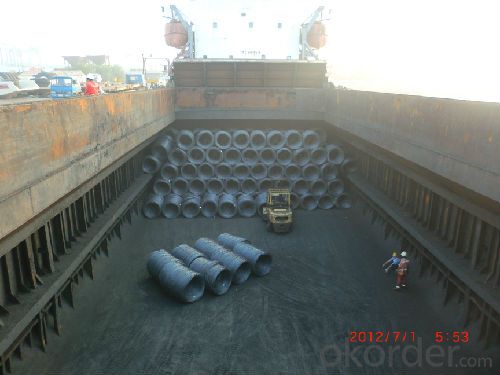
- Q: How is steel wire rod used in the manufacturing of wire rope assemblies for construction purposes?
- Steel wire rod is an essential component in the manufacturing of wire rope assemblies for construction purposes. Wire rope assemblies are widely used in construction for various applications such as lifting heavy loads, securing structures, and providing structural support. Steel wire rod serves as the raw material for producing the inner strands and outer strands of a wire rope assembly. These strands are made by twisting multiple individual wires together, forming a strong and durable rope. The wire rod used in this process is typically made from high-quality carbon steel, which provides the necessary strength and resilience required for construction applications. The manufacturing process begins with the steel wire rod being cleaned and coated with a lubricant to reduce friction during the twisting process. The wire rod is then drawn through a series of dies to reduce its diameter and increase its length. This drawing process helps to align the steel's grain structure, enhancing its strength and flexibility. Once the wire rod has been drawn, it is fed into a stranding machine where multiple wires are twisted together to form individual strands. These strands are then combined in a specific pattern to create the wire rope assembly, with the inner strands providing strength and the outer strands providing protection. The wire rope assembly is then subjected to various quality control measures to ensure it meets the required specifications for construction purposes. These measures may include testing for strength, flexibility, and resistance to corrosion. Once approved, the wire rope assembly is ready to be used in construction projects. In construction, wire rope assemblies made from steel wire rod are used for a wide range of applications. They are commonly used in cranes and hoists to lift heavy loads, providing a safe and reliable lifting solution. Wire rope assemblies are also utilized in the construction of suspension bridges, where they provide support and stability. Additionally, wire rope assemblies are used for securing structures, such as in the installation of safety barriers or anchoring systems. Overall, steel wire rod plays a crucial role in the manufacturing of wire rope assemblies for construction purposes. Its strength, durability, and versatility make it an ideal material for use in various construction applications, ensuring the safety and reliability of structures and equipment.
- Q: How is steel wire rod classified based on its end-use applications?
- Various categories exist for the classification of steel wire rod based on its end-use applications. One commonly used classification system is based on the intended wire production. For instance, there are wire rods specifically manufactured for construction purposes, such as reinforcing concrete structures or creating fences. These wire rods possess specific mechanical properties and are often corrosion-resistant to ensure durability in harsh environments. Another classification system is based on the wire rod's application in the automotive industry. Steel wire rods used for manufacturing automobile components, like springs, suspension systems, or seat frames, have different requirements in terms of strength, ductility, and fatigue resistance. Consequently, they are produced with specific chemical compositions and undergo specialized heat treatments to meet these demanding requirements. Furthermore, steel wire rod can be classified based on its application in the manufacturing of electrical wires and cables. These wire rods are designed to have exceptional conductivity properties and are frequently made from specific alloys, such as aluminum or copper-clad steel, to optimize electrical performance. Moreover, steel wire rods can also be classified according to their end-use applications in the manufacturing of various consumer goods. This encompasses wire rods used for producing wire ropes, nails, screws, bolts, and other fasteners. Depending on the intended use of the final product, these wire rods need to possess high tensile strength, good formability, and resistance to corrosion. In summary, the classification of steel wire rod is based on its end-use applications to ensure that it meets the specific requirements and performance expectations of various industries.
- Q: What are the common applications of oil tempered and quenched steel wire rod?
- Oil tempered and quenched steel wire rod is commonly used in various applications due to its unique properties. Here are some of the common applications: 1. Springs: Oil tempered and quenched steel wire rod is extensively used in the manufacturing of springs, especially those that require high strength and durability. It provides excellent resistance to fatigue, allowing the springs to withstand repeated loading and unloading cycles without failure. 2. Mechanical parts: The high tensile strength and toughness of oil tempered and quenched steel wire rod make it suitable for various mechanical parts that require reliability and resistance to wear and tear. These parts can include bearings, gears, shafts, and other components in machinery and equipment. 3. Automotive industry: Oil tempered and quenched steel wire rod is widely employed in the automotive industry for various applications. It is used in the production of suspension springs, valve springs, clutch springs, and other components that require both strength and elasticity. 4. Construction industry: Due to its high strength and resistance to corrosion, oil tempered and quenched steel wire rod finds applications in the construction industry. It is commonly used for reinforcing concrete structures, such as pre-stressed concrete beams and columns, as well as for manufacturing various types of wire mesh and fencing. 5. Wire ropes and cables: Oil tempered and quenched steel wire rod is often used as the core material in wire ropes and cables. The unique combination of strength, flexibility, and resistance to fatigue makes it ideal for applications that involve heavy lifting, towing, or suspension, such as cranes, elevators, and suspension bridges. 6. Oil and gas industry: The oil and gas industry relies on oil tempered and quenched steel wire rod for various applications. It is used in the manufacturing of downhole tools, such as drill pipes and sucker rods, as well as for wirelines and control cables that are crucial for exploration and production operations. In summary, oil tempered and quenched steel wire rod is versatile and finds applications in a wide range of industries. Its strength, durability, and resistance to fatigue and corrosion make it a preferred choice for springs, mechanical parts, automotive components, construction materials, wire ropes, and various oil and gas industry applications.
- Q: How is steel wire rod used in the manufacturing of wire for overhead power lines?
- Steel wire rod is used in the manufacturing of wire for overhead power lines by being drawn through a series of dies to reduce its diameter. This process, known as wire drawing, helps to increase the wire's strength and flexibility. The resulting steel wire is then stranded or twisted together to form a conductor that can efficiently transmit electricity over long distances. Additionally, the steel wire's corrosion resistance and high tensile strength make it ideal for withstanding the environmental challenges and mechanical stresses associated with overhead power lines.
- Q: How is steel wire rod used in the manufacturing of wire forms for bridge cables?
- Steel wire rod is a crucial component in the manufacturing of wire forms for bridge cables. It is primarily used as the raw material to produce the wire strands that make up the bridge cables. These wire strands are then twisted together to form the cables that provide the necessary strength and support for bridges. The steel wire rod goes through a series of processes to transform it into wire strands suitable for bridge cables. First, the rod is cleaned and descaled to remove any impurities and contaminants. It is then heated to a specific temperature and passed through a series of dies to reduce its diameter and increase its length. This process is known as wire drawing. After wire drawing, the steel wire rod is further processed through a stranding machine. Multiple wire strands are twisted together in a specific pattern to create a stronger and more durable cable. The twisting process ensures that the individual wire strands are tightly bound together, providing the necessary strength to withstand the load and tension experienced by bridge cables. The quality of the steel wire rod used in the manufacturing process is crucial to ensure the strength and performance of the bridge cables. It needs to have the right combination of tensile strength, ductility, and corrosion resistance. High-quality steel wire rod that meets specific standards and specifications is selected to ensure the reliability and longevity of the bridge cables. In conclusion, steel wire rod is a fundamental material used in the manufacturing of wire forms for bridge cables. It undergoes various processes, such as wire drawing and stranding, to create wire strands that are then twisted together to form the cables. The quality of the steel wire rod is essential to ensure the strength and durability of the bridge cables, making it a critical component in the construction and maintenance of bridges.
- Q: What are the safety precautions to be taken while handling steel wire rod?
- To avoid accidents or injuries when dealing with steel wire rods, it is crucial to adhere to specific safety measures. Consider the following important precautions: 1. Personal Protective Equipment (PPE): It is vital to wear suitable PPE, such as protective gloves, safety glasses, and steel-toed boots. This equipment will safeguard against cuts, bruises, and eye injuries. 2. Correct Lifting Methods: To prevent strain or back injuries, employ proper lifting techniques while handling steel wire rods. Lift with your legs, not your back, and refrain from twisting movements when lifting or carrying the rods. 3. Secure Storage: Store steel wire rods in a designated, well-organized, and secure area. This will prevent them from falling or rolling, which could cause harm. 4. Clear Pathways: Keep pathways free from obstructions, ensuring a safe and unobstructed route for transporting the rods. This will minimize the risk of tripping or slipping accidents. 5. Inspection for Defects: Prior to handling steel wire rods, thoroughly inspect them for any defects or sharp edges. Remove any damaged or defective rods from use to prevent injuries. 6. Proper Handling Equipment: Utilize appropriate handling equipment, such as forklifts or trolleys, when moving or transporting steel wire rods. Ensure that the equipment is in good working condition and operated by trained individuals. 7. Collaboration and Communication: When working in a team, effectively communicate with your colleagues to avoid accidents. Employ clear signals or verbal cues to coordinate movements and ensure everyone is aware of their surroundings. 8. Sufficient Lighting: Guarantee that the work area is well-lit to provide clear visibility and minimize the risk of accidents due to inadequate lighting conditions. 9. Training and Awareness: Implement thorough training for all personnel involved in handling steel wire rods. Educate them about potential hazards, safe handling techniques, and emergency procedures. 10. First Aid Preparedness: Maintain a well-stocked first aid kit and ensure that employees are trained in basic first aid to promptly address any injuries. By adhering to these safety precautions, you can effectively reduce the risk of accidents, injuries, and damage when handling steel wire rods. Always prioritize safety and take necessary measures to protect yourself and others in the workplace.
- Q: What is steel wire rod?
- Steel wire rod is a long, cylindrical semi-finished metal product that is produced through a series of rolling processes. It is made from high-quality steel and has a round cross-section. Steel wire rod is used as a raw material in various industries, such as construction, automotive, and manufacturing, where it is further processed into different forms of wire products, such as nails, bolts, springs, and wire mesh.
- Q: How is steel wire rod tested for resistance to stress corrosion cracking?
- Steel wire rod is tested for resistance to stress corrosion cracking through a series of standardized tests. One commonly used method is the slow strain rate testing (SSRT), where the rod is subjected to a controlled and slow deformation under corrosive conditions. The test measures the time it takes for cracks to initiate and propagate, providing valuable information about the material's susceptibility to stress corrosion cracking. Additionally, other techniques such as electrochemical testing and hydrogen embrittlement testing may also be employed to assess the resistance of steel wire rod to stress corrosion cracking.
- Q: How is steel wire rod used in the manufacturing of wire mesh strainers?
- Steel wire rod is used in the manufacturing of wire mesh strainers as the primary material for creating the mesh structure. The wire rod is drawn through a series of dies to reduce its diameter and increase its length. It is then woven or welded together to form a mesh pattern, which provides strength, durability, and the ability to filter out unwanted particles or debris when used as a strainer.
- Q: How is steel wire rod recycled at the end of its lifecycle?
- At the end of its lifecycle, steel wire rod can be recycled through a process called steel scrap recycling. This involves several steps to transform the wire rod into reusable steel materials. The first step in the recycling process is the collection of steel wire rod scraps. These scraps can come from various sources such as manufacturing waste, construction materials, or end-of-life products like old cars or appliances. Once collected, the scraps are sorted and separated based on their composition and quality. Next, the sorted steel wire rod scraps are sent to a recycling facility where they undergo a process called shredding. Shredding involves breaking down the wire rod into smaller pieces to facilitate further processing. This step can be done using different methods, such as hydraulic shears or industrial shredders. After shredding, the steel wire rod pieces are typically subjected to a process called magnetic separation. This is done to remove any non-ferrous materials like plastic or rubber that may be mixed with the scraps. Magnetic separators attract and remove these non-ferrous materials, leaving behind the steel wire rod pieces. The separated steel wire rod pieces are then further processed to remove any impurities or contaminants. This is typically done through a process called melting. The wire rod pieces are heated to extremely high temperatures in a furnace, causing them to melt. During this melting process, any impurities or contaminants are burned off or skimmed off the top of the molten metal. Once the impurities are removed, the molten steel is poured into molds to form new steel products. These molds can vary depending on the desired shape and size of the final product. Once the steel has solidified, it can be further processed and treated to meet specific requirements, such as tempering or strengthening. The recycled steel wire rod can then be used as raw material in various industries, including construction, automotive manufacturing, and appliance production. This reduces the need for extracting and refining virgin iron ore, conserving natural resources and reducing environmental impact. In summary, steel wire rod is recycled at the end of its lifecycle through a series of steps including collection, sorting, shredding, magnetic separation, melting, molding, and further processing. This process allows the steel to be reused in various industries, promoting sustainability and reducing the demand for new steel production.
Send your message to us
Hot Rolled Low Carbon Steel Wire Rod
- Loading Port:
- China Main Port
- Payment Terms:
- TT or LC
- Min Order Qty:
- 100 m.t.
- Supply Capability:
- 10000 m.t./month
OKorder Service Pledge
OKorder Financial Service
Similar products
Hot products
Hot Searches
Related keywords
